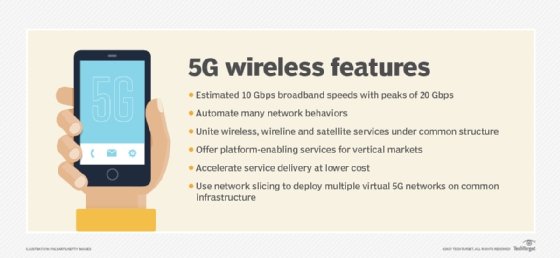
Tom Wang - stock.adobe.com
5G UC evens the mobile communications playing field
5G is improving the quality of UC services over mobile networks. Learn the advantages 5G UC offers remote workers compared to 4G LTE networks.
5G is the latest cellular technology that's taking the world by storm. The new wireless standard is an improvement over previous iterations, such as 4G LTE, in several key areas, which translates to more reliability, increased speed and decreased network latency from an end-user perspective.
Carriers such as AT&T, T-Mobile and Verizon are busy rolling out their 5G networks across the U.S. Now that 5G is available in many geographic locations, organizations are taking advantage of the performance gains of extra bandwidth and low latency in multiple business technologies, including mobile unified communications (UC).
Let's look at how 5G is eliminating many of the technical hurdles inherent in legacy 4G LTE wireless networks to the point where using 5G UC services is indistinguishable from the corporate LAN.
Mobile UC challenges on current-generation networks
When employees work outside of the corporate LAN and connect to legacy 4G LTE networks, concessions are often made from a UC perspective. UC services, such as video, that require higher rates of bandwidth, low latency and low jitter often suffer from quality issues as current-generation wireless carrier networks can't consistently meet minimum performance requirements.
It used to be that remote and mobile users found they were forced to change how they used UC tools to meet what the underlying cellular data network could support, which limited their ability to perform their job duties. This was an especially concerning problem during the COVID-19 pandemic. However, now that 5G is prevalent in most metropolitan areas, this concern has diminished, and users are growing increasingly comfortable when utilizing 5G networks while at home or on the go.
How 5G supports remote and hybrid work
5G greatly expands the physical locations where work can be accomplished. In areas where 5G is available, users working in locations like hotels and coffee shops can opt to use their phone or mobile hotspot service to tether their laptop. Users don't need to use guest Wi-Fi at these locations, which is prone to performance and security problems.
The ability to carry a 5G-connected device around in their pocket supports clearer audio and video while traveling, greatly enhancing the ability to communicate with others at a moment's notice.

The advantages of 5G UC over 4G LTE
Most mobile carriers are steadily replacing LTE as the last-mile wireless technology to connect customer devices to their network. While these rollouts have been slower than expected due to the pandemic and various component supply chain issues, most large carriers seem to be back on track. Without getting too deep into specifics, the performance benefits of 5G compared to LTE largely revolve around three key improvements:
- Speed. 5G is estimated to be up to 100 times faster than 4G LTE technologies. That said, the real-world performance increase will likely be in the five times to 10 times range. While this speed bump doesn't sound significant, it's more than enough to enable mobile UC users to use bandwidth-hungry services, such as streaming high-quality, real-time video.
- Latency. Perhaps even more important than bandwidth is network latency. 5G latency is expected to be nearly 10 times lower than 4G LTE technologies. The decreased latency enables any modern UC app to function on a 5G carrier network as it would on a corporate LAN.
Low latency is especially useful for the transport of real-time communications, such as high-definition voice and video. While users grew accustomed to audio or video stutters and significant frame rate drops when connecting to 4G LTE networks, those issues largely disappear once connected to a 5G tower. - Capacity. 5G wireless enables far more devices to simultaneously connect compared to previous technology generations. These include modern 5G-capable IoT devices. From a UC perspective, users will not only communicate with other UC users on 5G networks, but also with autonomous devices in a machine-to-human capacity. Thus, expect integrations with various IoT sensors, monitoring equipment and surveillance cameras to be a new capability within the world of mobile UC.
The challenges of 5G-enabled UC
Two major challenges tend to arise when it comes to using 5G networks for UC. First, since 5G isn't yet available in smaller cities or rural areas, users can't always count on 5G being available where they need it.
Second, the UC services being offered by an organization may still be located in an on-premises data center connected to the corporate LAN, as opposed to a global cloud service provider. This means that network traffic may have to traverse great distances to access UC servers over legacy VPN connections.
Both can diminish the throughput and network latency benefits of 5G, resulting in a subpar experience with stuttering voice and frozen video. Thus, it's important to remember that businesses must act now to revamp their UC architecture to an as-a-service model that will greatly improve remote workforce experiences.






